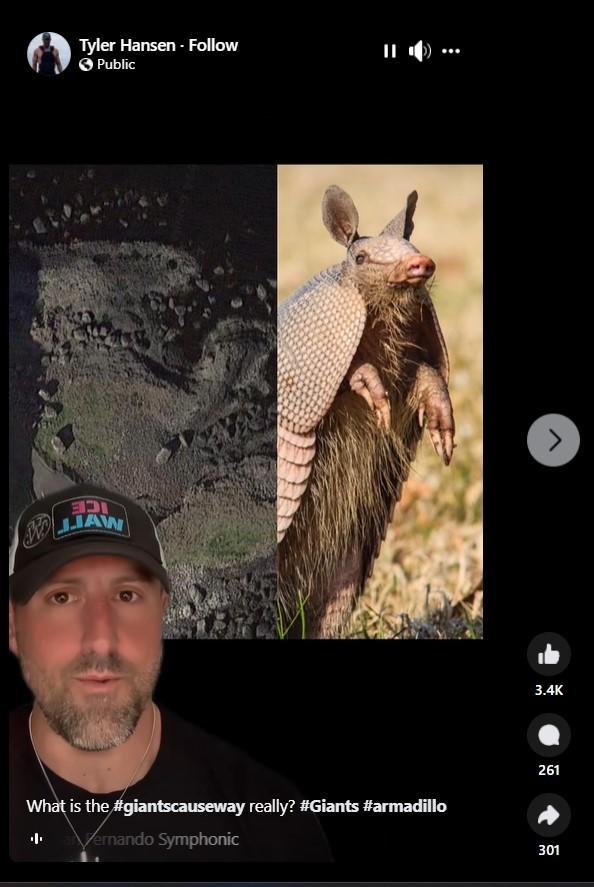
Is the site known as Giant's Causeway on the coast of Northern Ireland actually a giant petrified armadillo, visible from the air? No, that's not true: The unusual geometric rock formations seen at Giant's Causeway are basalt columns, which, according to experts, take their shape from the way molten volcanic basalt lava shrinks as it cools. Some stone surfaces resemble the texture of an armadillo's skin, but no credible source says they are the preserved remains of an enormous animal. The person who made this claim about Giant's Causeway on Facebook indicated that it was for entertainment purposes.
The claim appeared in a reel (archived here) on Facebook, posted by Tyler Hansen @TheFittestFlatEarther on May 14, 2024. The post was captioned with these hashtags:
What is the #giantscauseway really? #Giants #armadillo
This is what the post looked like on Facebook at the time of writing:
(Source: Facebook screenshot taken on Fri May 17 14:02:46 2024 UTC)
Early in the video, Hansen says that regular viewers of his channel know he believes "that everything we walk on was once a living creature." In the last seconds of this 1:30-minute-long reel, Hansen gives a disclaimer, but it abruptly cuts off:
But as always guys, you know that I am just here to entertain, and this is just some total coincidence that ...
Thirty-five seconds into the reel, after pointing out the similarities between an armadillo's skin and the texture of the Giant's Causeway stones, Hansen cuts to a satellite image of Giant's Causeway and zooms in on a portion of the shoreline that resembles the silhouette of an armadillo. In the reel, this land feature is contrasted to an image of a real armadillo in a similar pose (pictured above).
Lead Stories used Google Earth Pro to measure this shoreline feature. It is about 160 yards long from top to bottom -- that's about 96 times the length of the longest known armadillo (1.67 yards), which, according to Britannica Encyclopedia, lives in the Amazon, not Northern Ireland.
Lead Stories could find no proof that the armadillo, a warmth-loving South American native, also found in the United States, has ever lived in the damp British Isles.
Giant's Causeway is a designated United Nations Educational, Scientific and Cultural Organization (UNESCO) World Heritage Site, owned and managed by the United Kingdom's National Trust. The eighth criterion for selection listed in UNESCO's description of the site explains how this 50- to 60-million-year-old lava formation appeared. It makes no mention of a petrified armadillo:
Criterion (viii): The geological activity of the Tertiary era is clearly illustrated by the succession of the lava flows and interbasaltic beds which are in evidence on the Causeway Coast. Interpretation of the succession has allowed a detailed analysis of Tertiary events in the North Atlantic. The extremely regular columnar jointing of the Tholeiitic basalts is a spectacular feature which is displayed in exemplary fashion at the Giant's Causeway. The Causeway itself is a unique formation and a superlative horizontal section through columnar basalt lavas.
A U.S. National Park Service website page on Columnar Jointing provides additional information about how basalt columns actually are formed. It says:
The predominantly hexagonal pattern arises because contractional stress is most efficiently relieved by three fractures that intersect at angles of 120 degrees, which in turn creates six-sided polygons. Columns are oriented perpendicular to the main cooling surfaces of lava flows and other igneous bodies.
Columnar jointing forms after a lava flow or other igneous body has solidified, but while it is still at high to medium temperature. It is thought that columnar jointing forms during rapid cooling and that the development of the fracture system allows fluids to circulate which can further hasten the rate of cooling.
Basalt columns are not unique to Giant's Causeway. They are found around the world: Giant's Boot, Giant's Organ, Chimney Stacks and Giant's Harp, for instance.
A September 16, 2020, travel article on Fodors.com titled, "10 Jaw-Dropping Basalt Formations Around the World" shows photos of columnar formations in Iceland, Scotland, Armenia, Vietnam, Namibia, Tasmania, El Salvador, Mauritius, the United States and Northern Ireland. They each have visual peculiarities, which the article attributes not to armadillos, but to geology.
An example of these non-armadillo-like features can be seen at Devil's Postpile National Monument in California, where the top of the basalt columns resembles hexagonal paving stones (pictured below left). This is just a hint of the vertical columnar structure below the surface or exposed in a cliff wall (below right).
(Source: Wikipedia Creative Commons (here and here) downloaded on Fri May 17 21:24:55 2024 UTC)
Along with the claim of the giant armadillo, Hansen's reel contains several additional intermingled false claims that are outside the scope of this fact check. Lead Stories has debunked such claims in the past: notably, giant animal landforms, the ice wall and the firmament. Additional Lead Stories fact checks of claims about basalt columns and a flat earth can be found here and here.


















